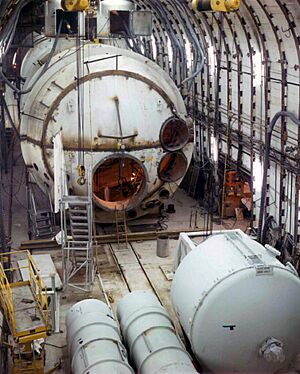Operation Toggle facts for kids
Quick facts for kids Operation Toggle |
|
|---|---|
| Information | |
| Country | United States |
| Period | 1972–1973 |
| Number of tests | 28 |
| Test type | underground shaft, tunnel |
| Max. yield | 250 kilotonnes of TNT (1,000 TJ) |
Operation Toggle was a series of nuclear tests carried out by the United States between 1972 and 1973. These tests involved setting off nuclear devices deep underground. There were 28 separate tests in this series. Operation Toggle happened after a series called Operation Grommet and before another one called Operation Arbor.
Contents
What Was Operation Toggle?
Operation Toggle was a program where the United States tested nuclear devices. These tests were done underground to prevent radioactive material from spreading into the air. The main goal was to improve nuclear weapons and understand their effects.
Where Did the Tests Happen?
Most of the tests in Operation Toggle took place at the Nevada Test Site (NTS). This is a large area in Nevada where the U.S. government used to conduct many nuclear tests. One special test, called Rio Blanco, happened in Colorado. This particular test was part of a project to see if nuclear explosions could help release natural gas from underground.
How Were the Tests Conducted?
The tests were done in two main ways:
- Underground Shafts: Imagine digging a very deep, narrow hole straight down into the ground. The nuclear device would be placed at the bottom of this shaft.
- Tunnels: For some tests, a long tunnel was dug into the side of a mountain. The nuclear device would be placed far inside the tunnel.
After the device was placed, the shaft or tunnel would be sealed up. Then, the device was exploded. This kept most of the explosion and radiation contained underground.
What Was the Purpose of These Tests?
The tests in Operation Toggle had different purposes:
- Weapons Development: Many tests were aimed at making nuclear weapons better or creating new types.
- Weapon Effect Studies: Some tests helped scientists understand how nuclear explosions affect different materials and structures underground. This was important for designing stronger bunkers or understanding damage.
- Safety Experiments: A few tests focused on making sure nuclear weapons were safe, even if they were accidentally dropped or damaged.
- Peaceful Research: The Rio Blanco tests in Colorado were part of a program called Operation Plowshare. This program explored using nuclear explosions for non-military purposes, like digging canals or, in this case, trying to get natural gas out of the ground. The Rio Blanco test involved three nuclear devices exploding at the same time in one deep hole to try and stimulate natural gas flow.
Key Facts About Operation Toggle
- Total Tests: There were 28 nuclear tests in the Operation Toggle series.
- Years Active: The tests happened between 1972 and 1973.
- Biggest Explosion: The most powerful test in this series was called Almendro. It had a yield of 250 kilotons (kt). To give you an idea, 1 kiloton is equal to the explosive power of 1,000 tons of TNT. So, 250 kilotons is like 250,000 tons of TNT!
- Venting: Sometimes, small amounts of radioactive gas would escape into the atmosphere after a test. This was called "venting" and was detected in some of the Toggle tests.
Operation Toggle was an important part of the United States' nuclear testing history during the Cold War. It helped develop and refine nuclear weapons technology while also exploring peaceful uses for nuclear explosions.


